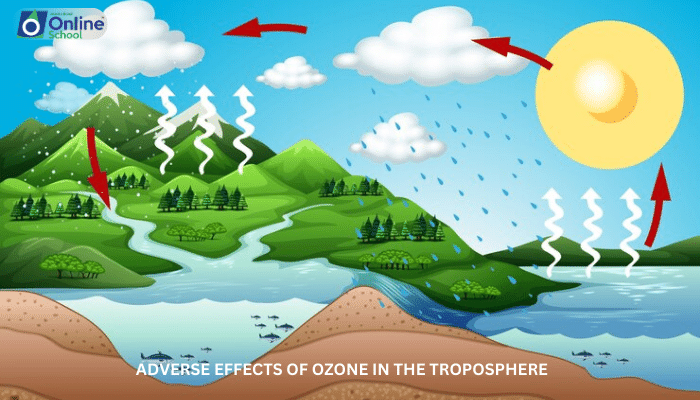
Learning Outcomes
By the end of this lesson, students should be able to:
i. Define ozone (O3) and distinguish between stratospheric ozone and tropospheric ozone.
ii. Explain the formation of tropospheric ozone through photochemical reactions involving volatile organic compounds (VOCs) and nitrogen oxides (NOx).
iii. Identify the adverse effects of tropospheric ozone on human health, including respiratory problems, eye irritation, and reduced lung function.
iv. Recognize the impact of tropospheric ozone on vegetation, leading to reduced crop yields and damage to plant tissues.
v. Discuss the factors that contribute to the formation of tropospheric ozone, such as sunlight, air pollution, and meteorological conditions.
vi. Appreciate the importance of emission control measures and air quality management strategies in reducing tropospheric ozone levels.
Introduction
Ozone, a molecule composed of three oxygen atoms (O3), plays a crucial role in the Earth's atmosphere. While stratospheric ozone forms a protective shield, absorbing harmful ultraviolet (UV) radiation from the sun, tropospheric ozone, found in the lower atmosphere, is a harmful air pollutant. This lesson delves into the adverse effects of tropospheric ozone, exploring its formation, impacts, and mitigation strategies.
i. Ozone in the Troposphere: A Double-Edged Sword
Ozone in the stratosphere, the upper layer of the atmosphere, acts as a protective shield, absorbing harmful UV radiation from the sun, preventing it from reaching the Earth's surface and protecting life from its detrimental effects. However, ozone in the troposphere, the lower layer of the atmosphere, is a harmful air pollutant.
ii. Formation of Tropospheric Ozone: A Chemical Dance
Tropospheric ozone is formed through photochemical reactions involving volatile organic compounds (VOCs) and nitrogen oxides (NOx) in the presence of sunlight.
VOCs: VOCs, emitted from various sources, such as vehicles, industrial processes, and vegetation, react with sunlight to produce free radicals.
NOx: NOx, primarily from vehicle emissions and industrial processes, react with free radicals to produce ozone.
iii. Adverse Effects of Tropospheric Ozone: A Silent Threat
Tropospheric ozone poses significant health and environmental risks.
Human Health: Ozone can cause a range of respiratory problems, including coughing, wheezing, and shortness of breath. It can also irritate the eyes and reduce lung function.
Vegetation Damage: Ozone can damage plant tissues, leading to reduced crop yields, reduced plant growth, and increased susceptibility to diseases.
iv. Factors Influencing Ozone Formation: A Complex Equation
The formation of tropospheric ozone is influenced by various factors:
Sunlight: Sunlight provides the energy for the photochemical reactions that lead to ozone formation.
Air Pollution: VOCs and NOx, the primary precursors of ozone, are emitted from various sources, contributing to ozone formation.
Meteorological Conditions: Wind patterns, temperature inversions, and atmospheric stability can influence ozone formation and transport.
v. Mitigation Strategies: Taming the Tropospheric Ozone Beast
Reducing tropospheric ozone levels requires a multifaceted approach:
Emission Control Measures: Implementing stricter emission standards for vehicles and industrial processes can significantly reduce the release of VOCs and NOx, the precursors of ozone.
Air Quality Management: Enforcing air quality regulations, promoting cleaner fuels and technologies, and encouraging public transportation can help reduce ozone formation and improve air quality.
Public Awareness: Raising public awareness about the health and environmental impacts of tropospheric ozone can encourage individuals to adopt ozone-friendly practices.
Tropospheric ozone, a harmful air pollutant, poses significant threats to human health and the environment. Understanding its formation, impacts, and mitigation strategies is crucial for addressing this pressing issue. By implementing effective emission control measures, promoting cleaner technologies, and raising public awareness, we can work towards reducing tropospheric ozone levels and creating a healthier environment for all.